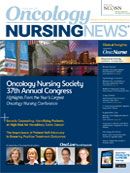A Patient Is His Own Best Advocate
Patients (and even clinicians) often don't know which facilities are considered leaders in the treatment of various types of cancer, and a bit of detective work is generally required.
John Saltanovitz and his wife, Leah
In early August 2004, 44-year-old John Saltanovitz began to experience difficulty breathing, which he attributed to a sinus infection or allergies. The symptoms persisted despite John’s use of over-the-counter sinus medications, and on August 31, after he and his wife, Leah, noticed that his left eye seemed to be protruding, he saw his family physician.
The doctor put John on a course of antibiotics for what appeared to be a sinus infection but, concerned about the eye, scheduled magnetic resonance imaging (MRI) for September 16. The MRI revealed a mass in the sinonasal area described as “likely malignant” and, the next day, a biopsy was performed by an ear, nose, and throat specialist, who recommended that John see an oncologist immediately.
On September 28, John was seen at a world-renowned cancer center, where he was diagnosed with undifferentiated sinonasal carcinoma (T-4B) with invasion into the brain and into the eye, causing cranial nerve damage and ophthalmic extrusion. The tumor was deemed nonresectable, and no curative options were offered.
John decided to seek a second opinion and was seen at the University of Chicago Comprehensive Cancer Center (UCCCC) in early October. The diagnosis was confirmed with a repeat MRI and panendoscopy, and distant metastasis was ruled out with computed tomography (CT).
On October 12, John began three cycles of outpatient induction chemotherapy with cisplatin and paclitaxel. He tolerated the treatment well, and post-treatment MRI showed that his tumor had become appreciably smaller.
On November 28, a port was inserted and John began five cycles of chemotherapy (paclitaxel, 5-FU, hydroxyurea) with concomitant radiation, administered in a 5-days-on, 9-days-off regimen.
John recalls feeling fine until he was being prepared for discharge after the first week of treatment, and needed to be readmitted through the emergency department with a fever and severe mucositis. He also had apparent 5-FU-related hand/foot syndrome, causing the skin to peel off his hands and feet, for which he was treated with topical creams and instructed to wear gloves and socks, which he changed three to four times daily. Because of the mucositis, a g-tube was inserted during this hospital stay, and remained in place until the end of April.
Roughly 1 month after completion of John’s chemotherapy, a repeat MRI showed that a complete response had been achieved, and a subsequent biopsy confirmed that John had no evidence of cancer. Scans performed during 5 years of follow-up continued to show no evidence of cancer.
John describes residual treatment-related effects as episodic nose bleeds, a diminished sense of smell, increased nasal drainage, and dryness in the nasal passages requiring once-daily rinses with moisturizing drops. He also reports blocked tear ducts and excess watering.
Allison Dekker, BSN, RN, OCN®
Nursing Considerations
Allison Dekker, BSN, RN, OCN®, began educating and preparing John for treatment during his initial visit to UCCCC. She explained that the most common adverse effects seen with the selected induction chemotherapy are nausea and vomiting, as well as nephrotoxicity. Patients are typically pre-medicated with the NK1 receptor antagonist Emend (Merck) to prevent nausea, are given IV fluids to flush the kidneys, and are instructed to keep well-hydrated throughout treatment, she said.
The mucositis and dermatitis John experienced after radiation and chemotherapy are typical side effects of that regimen, Dekker added. “We first attempt to manage the mucositis symptoms with a grade I mouth wash used four times daily but, as in John’s case, a feeding tube often needs to be inserted,” she said. She added that, due to skin breakdown, “we need to be especially vigilant about keeping the neck area clean and dry, and often use a triple-antibiotic ointment and a Vigilon dressing to manage pain and help prevent infection.”
Dekker noted that “head and neck cancers can adversely impact a patient’s ability to speak, eat, and even swallow,” so many patients are referred to a speech and swallowing specialist. Due to nausea from treatment, she added, patients are encouraged to eat a diet high in fat, calories, and protein between rounds, and typically meet with a nutritional specialist before therapy begins.
The Second Opinion: The Importance of Self-Advocacy
“John’s case illustrates the importance of a patient’s willingness and ability to be his own advocate,” said UCCCC physician Ezra Cohen, MD, noting that John’s decision to seek out a second opinion was what saved his life. Even so, patients (and even clinicians) often don’t know which facilities are considered leaders in the treatment of various types of cancer, Cohen said, and a bit of detective work is generally required.
Patients (and even clinicians) often don’t know which facilities are considered leaders in the treatment of various types of cancer, and a bit of detective work is generally required.
Not surprisingly, John is grateful not only to his physicians and nurses, but also to his wife and other family members and friends, all of whom refused to let him give up his fight.
Initially, he said, “we were at one of the best cancer centers in the world, but it was on the suggestion of one of the physicians in that center, and with my wife’s research and persistence, that we ended up at a facility that has pioneered many of the treatments used for my type of cancer.”
Laura Bruck is a freelance writer and editor based in Cleveland, Ohio. She has specialized in healthcare reporting since 1987.
Download PDF



